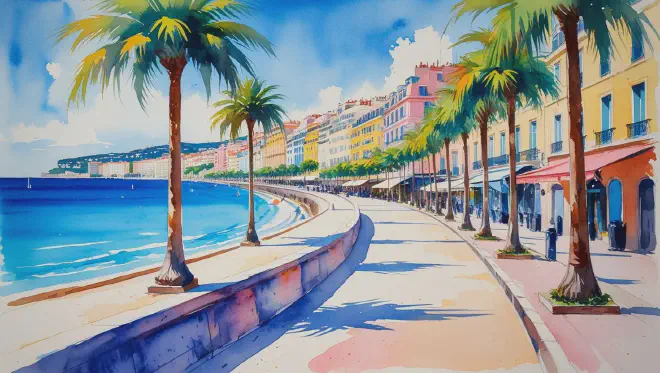Introduction: The Azure Sea and City of Eternal Sunshine
Nice, known as the pearl of the Côte d’Azur, has captivated hearts for centuries with its breathtaking panorama where the blue Mediterranean Sea melts seamlessly into the endless sky. In the 19th century, British aristocrats cherished this coastal haven as their winter retreat, while in the 20th century, artists like Matisse and Chagall found inspiration in this luminous city that seemed to capture light itself.
The charm of Nice lies in its geographical blessing. Behind the city, the Alpine mountains rise majestically, while the Mediterranean stretches endlessly ahead. This perfect topography creates a unique microclimate that remains temperate and pleasant throughout the year, allowing the distinctive unhurried pace of southern France to flow through every street corner. In the old town of Vieille Ville, ochre-colored buildings line maze-like alleys, while the Provençal markets display vibrant vegetables and flowers in a riot of colors. Above all, it is the warmth of the local people that embraces every visitor’s heart with genuine tenderness.

Day 1: First Steps in Golden Light
The TGV journey from Paris took about five and a half hours. As I watched the landscape gradually transform into the characteristic rolling hills of southern France through the window, my heart was already envisioning Nice’s azure waters. The moment I stepped off at Nice-Ville station, the dry southern air and gentle sunshine embraced my cheeks. Despite being late October, it was much warmer than Paris—a light cardigan was more than sufficient.
Riding the tram toward Place Masséna, my heart leaped at the cityscape unfolding beyond the windows. Buildings with terracotta roof tiles and soft pink or cream-colored facades lined the streets in perfect harmony, with palm trees threading gracefully between them. Even at this early moment, I felt myself being drawn into Nice’s distinctive allure.
My accommodation was a small boutique hotel tucked away in a corner of the old town. After checking in and dropping off my luggage, I ventured out to explore the streets. Around 2 PM, feeling the need for sustenance, I headed to a small bistro called Croix de Marbre, recommended by a local. It was hidden away beyond cobblestone alleys—truly a secret hideaway.
The interior buzzed with locals, their French conversations creating a pleasant symphony. Though many dishes on the menu were unfamiliar, the owner—a kindly man—recommended “pissaladière” in broken English. This Nice specialty turned out to be an onion and anchovy tart: thin bread topped with slowly caramelized onions, anchovies, and black olives. One bite revealed the perfect harmony between the onions’ sweetness and the anchovies’ saltiness, filling my mouth with the honest flavors of this land.
After lunch, I wandered through the old town. At the flower market in Cours Saleya, mimosa, carnations, and roses created a vibrant tapestry. A flower vendor called out “Bonjour!” and patiently listened to my clumsy French attempts at conversation. The small mimosa bouquet she selected was perfect for my room, its tiny yellow flowers seeming to bless the beginning of my journey.
As evening approached, I made my way to the Promenade des Anglais. This seaside walkway is Nice’s most iconic feature—a beautiful 7-kilometer promenade along the Mediterranean, created by British residents in the 19th century, earning it the nickname “the English Promenade.” Walking while listening to waves lapping against the pebble beach, I felt myself gradually releasing the tensions of daily life.
As the sun set over the sea, I enjoyed an apéritif at a café along the promenade. Sipping local rosé wine while nibbling baguette spread with olive tapenade, orange-tinted sky and sea spread before me. At the neighboring table, an elderly couple—probably married for over fifty years—shared wine with such natural, practiced gestures that it filled me with inexplicable warmth.
For dinner, I ordered the regional specialty bouillabaisse at a restaurant in the old town. The waiter carefully explained the traditional way of eating this seafood-rich soup mixed with rouille, a garlic mayonnaise-like sauce. It was the perfect ending to the day—a dish that warmed both body and soul.
Walking back to my hotel, hearing only my footsteps echoing on the cobblestones in the peaceful silence, I realized this city was already becoming something special to me.
Day 2: Embraced by Colors and Fragrances
The morning light coaxed me from bed early. From my hotel’s small balcony, the Mediterranean’s blue sparkled beyond the old town’s rooftops. Breakfast was a croissant and café au lait from a nearby bakery. When the baker realized I was a foreigner, she took special care in selecting the finest croissant for me. Such thoughtful kindness transformed an ordinary morning in a foreign land into something extraordinary.
I decided to visit the Chagall Museum in the morning. Taking a local bus through residential neighborhoods to reach the museum, I glimpsed Nice’s authentic face through the windows—laundry hanging from apartment balconies, small shops, people out for walks—scenes quite different from the tourist areas.
The Chagall Museum, located in Nice where Chagall spent his final years, specializes in displaying his works. The series called “Biblical Message” was particularly breathtaking, with blue-dominated fantastical colors enveloping the entire exhibition space. Chagall’s works created in this southern French light seemed somehow warmer, filled with hope. In the museum’s garden, Mediterranean plants swayed gently in the breeze, creating a harmonious space where art and nature merged. I lost track of time in this peaceful setting.
Lunch was at a small crêperie near the museum. I ordered a galette—a savory buckwheat crepe topped with ham, cheese, and egg. Though originally from Brittany, it was deliciously prepared here in Nice as well. The accompanying cider, an apple-based alcohol, perfectly complemented the galette’s rustic flavors.
In the afternoon, I returned to the old town for deeper exploration of its alleys. Wandering through the maze-like narrow streets, I discovered small ateliers and workshops. At a potter’s workshop, I watched the craftsman work at his wheel. Though we shared no common language, his concentrated expression and the clay’s transformation into beautiful forms conveyed the pure joy of creation.
Even in the afternoon, Cours Saleya market retained its vitality. At stalls selling Provence’s specialty herbs, spices, olive oil, and soaps, I purchased lavender soap. The shopkeeper let me smell each soap individually until I found my favorite. Its gentle fragrance became a treasure I could carry home along with my travel memories.
In the evening, I found the entrance to Castle Hill Park (Colline du Château). This park atop a hill where a castle once stood offers breathtaking views of Nice and the Mediterranean. As I climbed the stone steps, breathing heavily, a local man called out in English, “Almost at the top now!” Such casual kindness makes travel memories truly warm.
The view from the summit was breathtakingly beautiful. The Bay of Angels (Baie des Anges), as Nice’s coastline is called, curved gracefully while the Promenade des Anglais stretched like a single line. The setting sun painted the entire city golden, and the Mediterranean’s blue merged with the sky’s blue. This moment’s beauty was something that couldn’t be captured in photographs—it was etched deep in my heart.
For dinner, I ate at a bistro popular with locals. Though the combination of ratatouille and roast chicken was simple, each vegetable carried the sun’s blessing in its rich flavor. Watching a neighboring family enjoying their meal together, children included, I sensed the southern French people’s rich approach to life.
Day 3: Morning of Farewell and Eternal Memory
On my final morning, I woke earlier than usual. Perhaps my heart sensed the approaching farewell to this city. After packing and checking out, I stored my luggage in a station locker to spend my last few precious hours meaningfully.
My morning walk took a different route than before. I headed to Libération Market, where locals do their daily shopping. This wasn’t a tourist destination but a place where the city’s authentic life breathed. The fishmonger displayed fresh Mediterranean catches, while the greengrocer piled colorful vegetables and fruits in abundance. The cheese shop owner, recognizing me as a foreigner, offered me a taste of small goat cheese. Its rich yet gentle flavor embodied the southern French terroir itself.
After market shopping, I walked the Promenade des Anglais one last time to bid the sea farewell. The morning sea showed yet another different expression. The gentle waves lapping against the pebble beach seemed to echo my reluctance to leave this city.
Sitting on a promenade bench, I opened the paperback I’d brought, but found my attention drawn more to the scenery before me than to the words. Young couples strolled hand in hand, elderly people walked their dogs, joggers passed by. These everyday scenes felt somehow precious, as if I were witnessing something rare.
Before noon, I returned to the old town for a final farewell. Passing the bistro where I’d eaten on my first day, I spotted the same owner preparing for the day ahead. When our eyes met, he waved in greeting. That he remembered me after just two days of acquaintance filled me with joy.
Train time to the station was approaching. I retrieved my luggage from the locker and headed to the TGV platform. Watching Nice’s cityscape recede through the window, these three days slowly organized themselves in my mind.
My time in Nice wasn’t filled with spectacular events. Yet the smiles exchanged at the morning market, the silence felt in the museum, the sunset viewed from the coast, the craftsman encountered in an alley, the elderly couple sitting beside me at the café—all these became irreplaceable experiences.
Perhaps travel isn’t just about visiting new places, but about breathing a place’s air, feeling people’s warmth, and confronting oneself within a different flow of time. Nice quietly taught me this essential truth about travel.
Conclusion: Something Felt Real Despite Being Imaginary
From the TGV window heading back to Paris, watching the ever-changing landscape, I was enveloped by a strange sensation. The people I’d met, the food I’d tasted, the wind I’d felt, the scenery I’d witnessed during these three days—all seemed etched in my heart as if truly experienced.
The fragrance of the mimosa bouquet adorning my hotel room, the scent of lavender soap from Cours Saleya market, the honest flavor of pissaladière, the sunset’s beauty from Castle Hill Park. These memories live as authentic experiences in my heart, created through imagination even without physically being there.
Travel’s magic doesn’t lie solely in physical movement. It also dwells in the heart’s journey toward new places, imagining encounters with unknown cultures and people, feeling a land’s history and character. Even in imaginary travel, when we direct our thoughts toward a place with deep affection and respect, a genuine journey begins within our hearts.
Nice’s blue sea and warm people, cobblestone alleys and colorful markets, the gentle time that flows like southern French sunshine—all exist genuinely within my heart. While cherishing these memories as precious treasures, I hope that someday I’ll truly visit this land they’ve shown me.
Travel means not only walking with our feet but feeling with our hearts. This three-day imaginary journey to Nice became a special time that reminded me of this truth.

